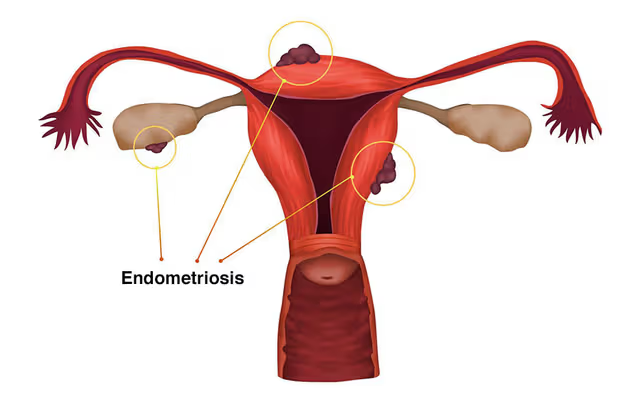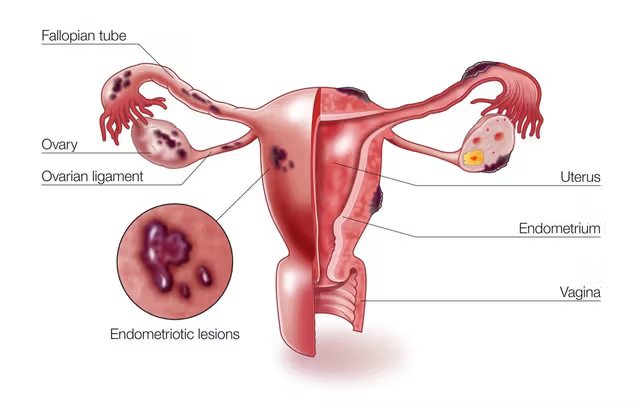
Understanding Endometriosis: The Four Stages and Why Diagnosis Takes So Long.

For many women, the journey to a proper endometriosis diagnosis is long and frustrating, often taking seven to 10 years from the onset of symptoms. Endometriosis is a chronic condition where tissue similar to the lining inside the uterus, known as the endometrium, grows outside the uterus. Despite affecting approximately 10% of women of reproductive age (about 176 million women worldwide), it remains one of the most misdiagnosed and misunderstood medical conditions. This delay significantly impacts quality of life, leading to chronic pain, infertility, and psychological distress.
•Facts About Endometriosis
Endometriosis is categorized into four stages, based on the extent, depth, and location of the endometrial implants, as well as the presence and severity of adhesions and ovarian endometriomas (cysts).
Stage I: Minimal
– A few tiny spots or implants of endometrial tissue, similar to freckles, are scattered in the pelvic area.
– The spots are mainly on the surface and have not deeply embedded.
– Symptoms may be mild or nonexistent, often mistaken for normal period pain.
– Minimal or no scar tissue (adhesions).

Stage II: Mild
– More numerous and slightly deeper spots, like darker freckles.
– Implants are mostly on the surface but increasing in number.
– Noticeable discomfort or pain during periods may start.
– Mild scar tissue (adhesions) may be present but not causing major issues.
Stage III: Moderate
– Implants grow deeper into the tissues, turning into small patches below the surface.
– Small cysts may form on one or both ovaries.
– Scar tissue or adhesions start forming, causing organs to stick together, leading to increased discomfort.
Stage IV: Severe
– Extensive endometrial tissue, with large, deep patches and significant cysts on the ovaries (endometriomas).
– Serious adhesions causing organs to stick tightly together.
– Severe pain affecting daily life, not just during menstruation.

•Why Endometriosis Is Often Misdiagnosed
Endometriosis is often misdiagnosed due to a variety of factors, as highlighted by several research studies:
1. Symptom Overlap with Other Conditions : Symptoms often resemble those of irritable bowel syndrome (IBS), pelvic inflammatory disease (PID), and ovarian cysts.
2. Normalization of Menstrual Pain : Severe menstrual pain is frequently dismissed as normal, delaying medical consultation and diagnosis.
3. Invasive Diagnostic Procedures : Laparoscopic surgery, an invasive procedure, is often required for a definitive diagnosis. Less invasive methods can be inconclusive.
4. Variable Symptom Presentation : The wide range of symptoms varies significantly among individuals, leading to misdiagnosis. Some women have severe disease with minimal symptoms, while others have severe symptoms with minimal disease.
5. Bias and Gender Disparities in Healthcare : Gender biases can lead to women’s pain being underestimated or dismissed by healthcare providers.
6. Slow Diagnostic Pathway : Many women see multiple healthcare providers over several years before receiving a diagnosis.
•Avoiding Misdiagnosis of Endometriosis
Avoiding the misdiagnosis of endometriosis requires a multi-faceted approach involving increased awareness, better education for healthcare providers, improved diagnostic methods, and enhanced patient advocacy. Here are some strategies to help avoid misdiagnosis:
1. Education and Training for Healthcare Providers:
– Specialized Training : Ensure that gynecologists and primary care physicians receive specialized training in recognizing and diagnosing endometriosis.
– Continuing Education : Regularly update healthcare providers on the latest research and diagnostic techniques related to endometriosis.
2. Increased Awareness and Advocacy:
– Public Awareness Campaigns : Increase public awareness about endometriosis through campaigns that educate about symptoms and the importance of early diagnosis.
– Support Groups : Encourage the formation and participation in support groups for women with endometriosis to share experiences and information.
3. Improved Diagnostic Techniques:
– Non-Invasive Testing : Invest in research for non-invasive diagnostic tests, such as blood tests or imaging techniques, to reduce the reliance on laparoscopic surgery.
– Advanced Imaging : Use advanced imaging techniques like MRI and transvaginal ultrasound to identify endometriosis lesions more effectively.
4. Comprehensive Symptom Assessment:
– Detailed Medical Histories : Take thorough medical histories, focusing on menstrual cycles, pain levels, and family history of endometriosis.
– Symptom Tracking : Encourage patients to keep detailed symptom diaries to help identify patterns and provide valuable information to healthcare providers.
5. Multidisciplinary Approach:
– Collaboration Between Specialties : Facilitate collaboration between gynecologists, gastroenterologists, urologists, and pain specialists to address overlapping symptoms and ensure comprehensive care.
– Holistic Care : Provide holistic care that includes pain management, mental health support, and fertility counseling.
6. Patient Empowerment:
– Education : Educate patients about endometriosis and encourage them to advocate for their health, seeking second opinions if necessary.
– Self-Advocacy : Empower patients to discuss their symptoms openly with healthcare providers and insist on thorough investigations if they feel their concerns are being dismissed.
7. Research and Funding:
– Increased Research : Invest in research to better understand the causes, progression, and effective treatments for endometriosis.
– Funding : Allocate funding for endometriosis research, public education programs, and support services.
Conclusion
The widespread nature of endometriosis and the significant delay in diagnosis highlight the need for increased awareness, timely diagnosis, and effective management. By addressing these challenges and implementing strategies to avoid misdiagnosis, we can improve the quality of life for those affected by this chronic condition.
Article By Suzy Nyongesa.
